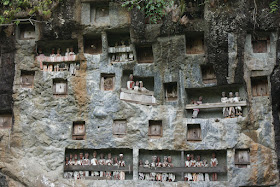One of the most beautiful tourist destinations of Indonesia, the green hills of South Sulawesi are home to the Toraja, a tribe that still honors the old Austronesian lifestyle, similar to Nias culture. Most tribe members are Christians, converted during Dutch colonization, but traces of their old beliefs still remain and are most visible during funeral festivities and burial customs. The Toraja are obsessed with death, but not in a tragic sense; to them funerals are a lot like going-away parties celebrated by sacrificing dozens of buffaloes and pigs for a feast enjoyed by the entire community.
The main concern of a Toraja tribe member is to make sure he raises enough money so his family can throw the best party in town, when he leaves this world. Their bodies are stored under the family home for years after their death. During this time the remaining relatives refer to that person not as “the deceased” but as “the sick”, and raise money for the actual funeral, which is usually attended by hundreds of guests. Tourists are welcome to attend the festivities, as long as they don’t wear black or red.
 |
| Cliff burial site at the Lemo village |
While churches dot the Toraja countryside, tribe members are rarely buried in the ground. They are either placed in tombs dug into nearby cliffs, or in wooden coffins hanging on the side of mountains. Lemo, one of the most popular burial sites in the area, looks like a big piece of rock Swiss cheese, with holes carved to fit coffins and balconies for the “tau tau” – life-size wooden effigies representing the deceased. In the old days, effigies only showed the deceased’s gender, but now master carvers try to make them look like the actual person. After the body has been placed in its rock tomb, the dead’s effigy is placed along others, in a carved balcony, so his spirit can watch over his descendants. Unfortunately, so many tau tau effigies have been stolen to be sold to tourists that people have started to keep them in their house.
At Ke’te’ kesu’, the dead are not placed in cliff-dug graves, but in wooden caskets hanging from the side of cliffs. The coffins are beautifully decorated with geometrical shapes, but over time the wood begins to rot and the bleached bones of the deceased often exposed. Some Toraja members are so resourceful that they pack the bones of several family members into a single coffin, which eventually causes the sustaining poles to break under the weight. But, judging by the piles of wood and bones at the bottom of the suspended burial ground, this doesn’t seem to bother anyone.
 |
| Tana Toraja - Burial coffins in the wall in Ke'te Kesu |
The smallest of the Toraja burial grounds are the “Baby Trees” where the tribe’s young are placed. If a child dies before he has started teething, its mother wraps his body in cloth, makes a another hole in the Baby Tree and places the dead infant inside. The hole is then sealed and as the tree begins to heal, the child is believed to be absorbed.
In the past time ,when the babies died early and haven't teeth yet, they have to be burried on the living tree that's mean the people have to make hole on that tree.the babies are covered also with the white clothes which symbolizes holy.the reason why the people burried the babies on the living tree because the babies have no sin ,so the soul of the babies can grow up like a living tree and the tree latex will be changed as a mother milk. so when the hole of the tree closed it's self the toraja people beliefe that the soul of the babies arrive in paradise called in toraja language ''Puya'' land of the souls
As bizarre as these burial customs may seem to us, the Toraja regard them as a huge part of their tradition, and are struggling to keep them alive in a modern world.
 |
| Londa, Rantepao, North Toraja |
 |
| Old coffins on rock ledges at Lemo |
 |
| Tana-Toraja-cliff-coffins |
 |
| Effigies of the dead and coffins inside the rock face |
Source




